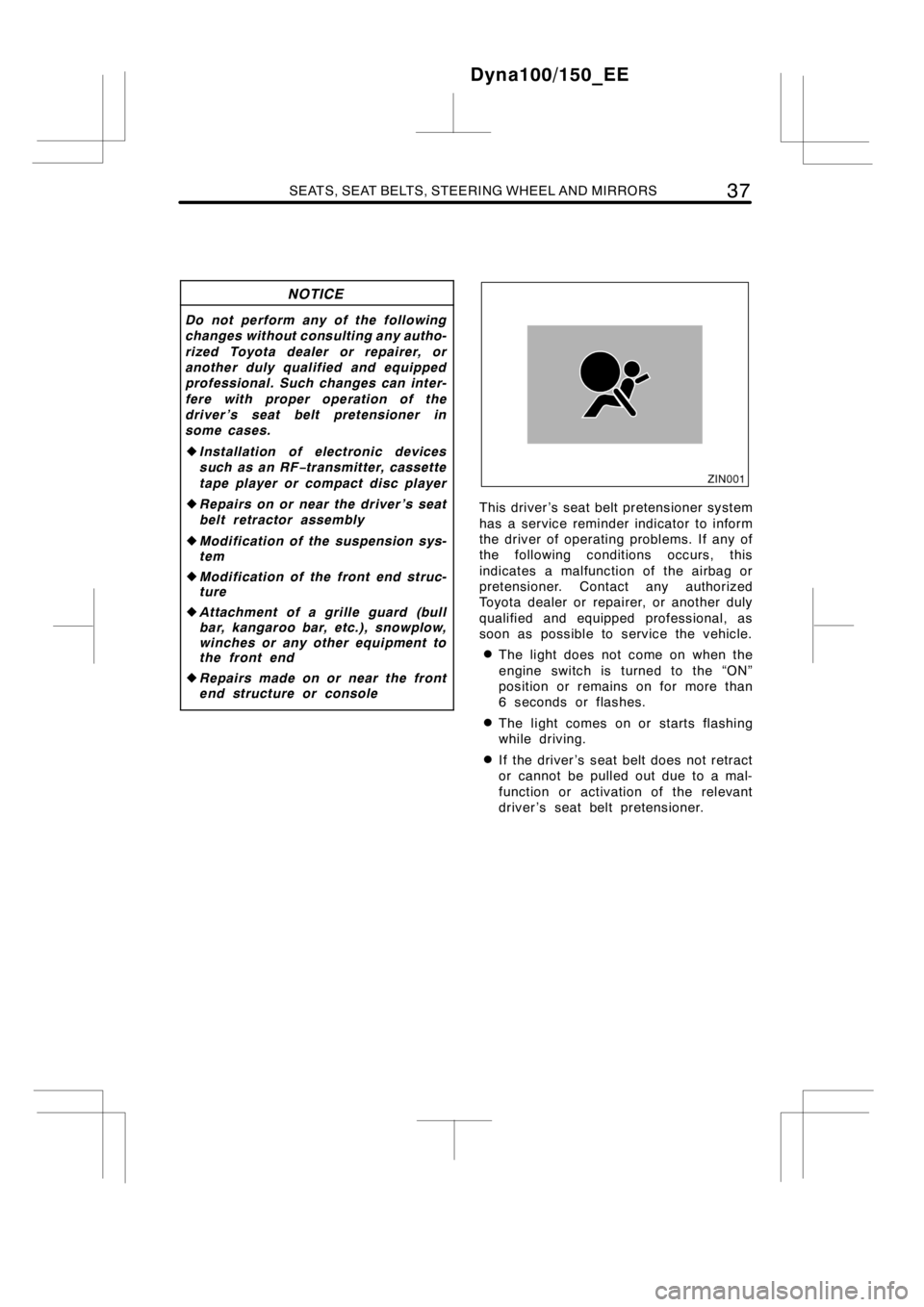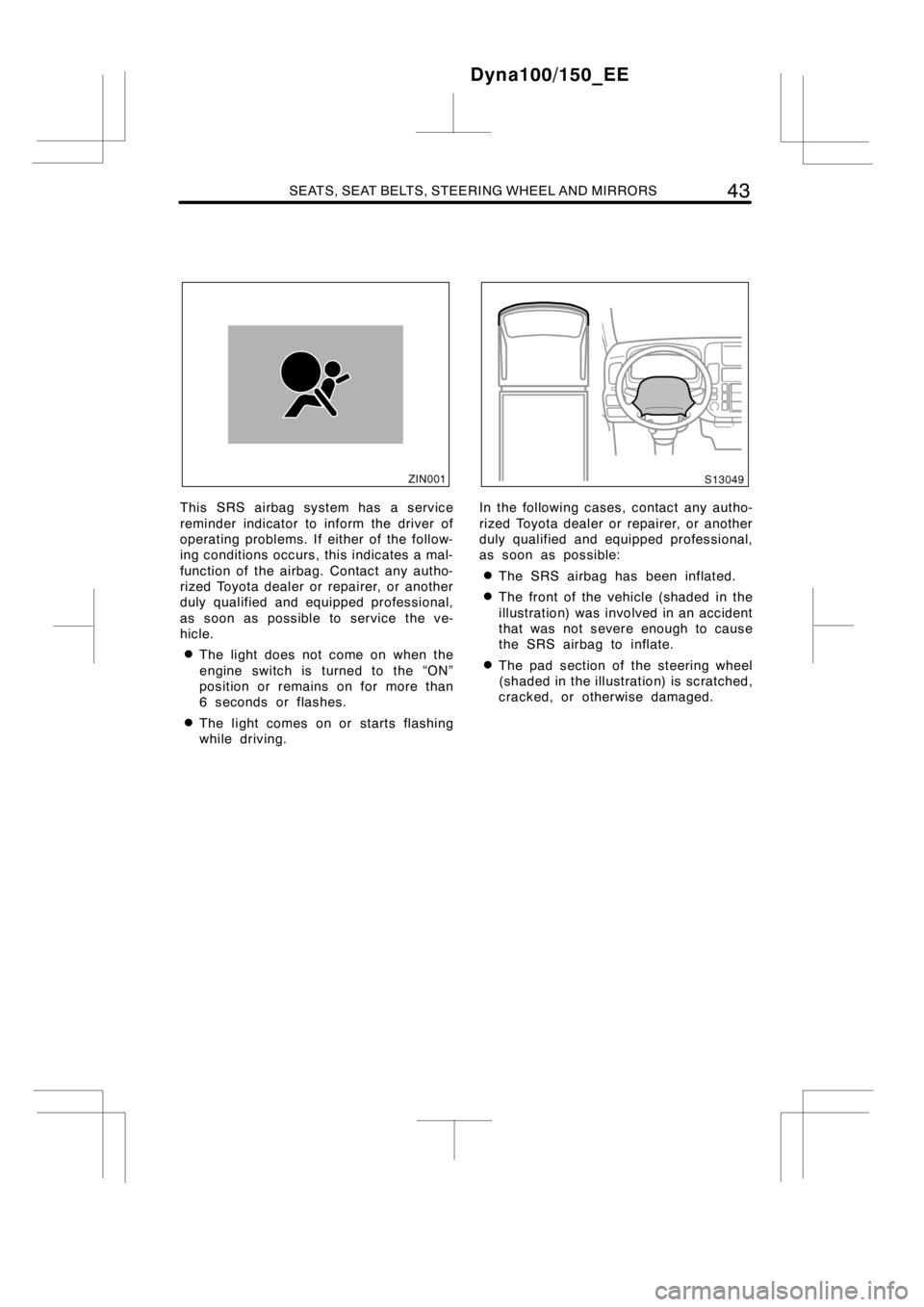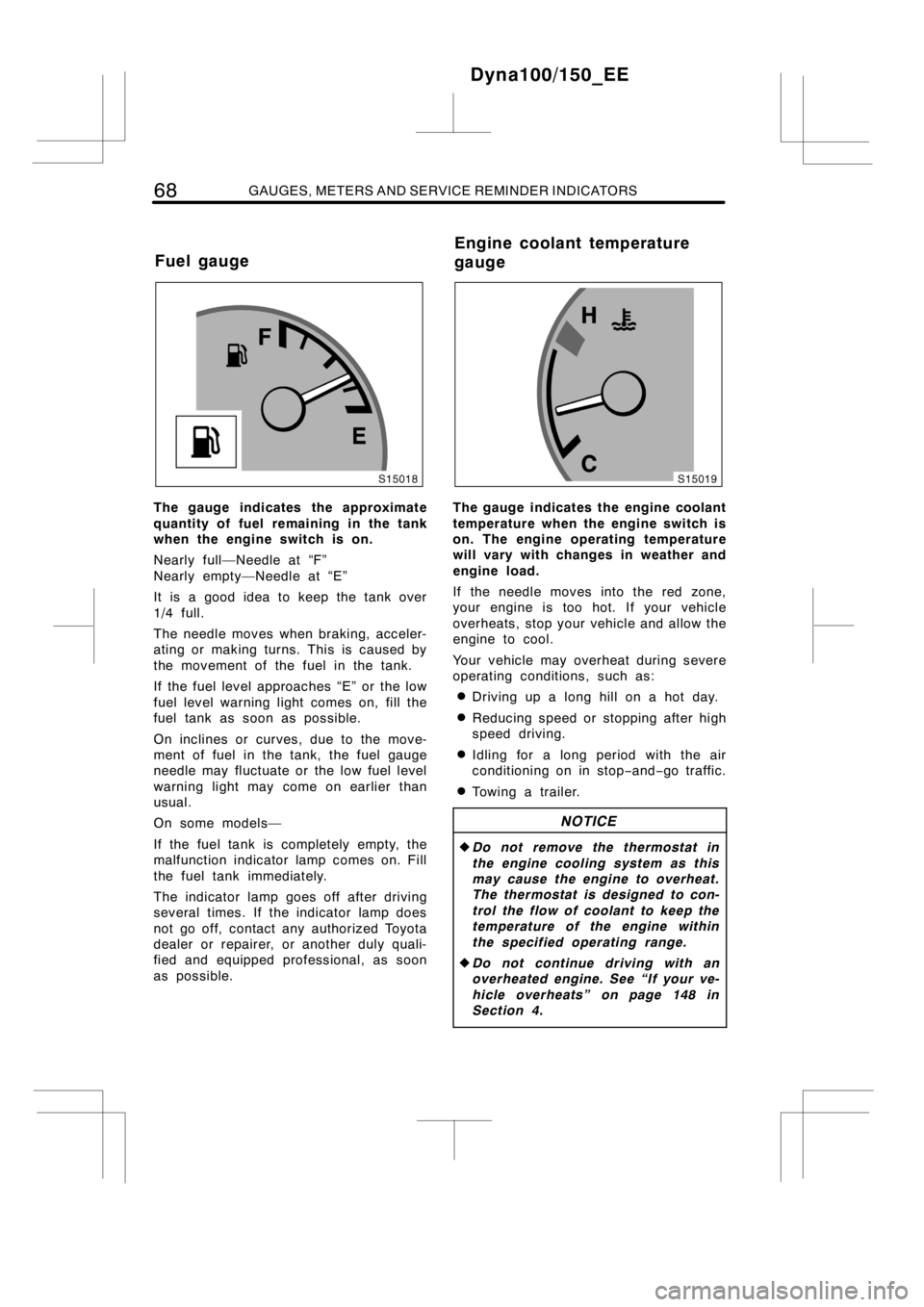2014 TOYOTA DYNA 100/150 air condition
[x] Cancel search: air conditionPage 5 of 232

v
Table of contents
1 OPERATION OF INSTRUMENTS AND CONTROLSPage
1 Overview of instruments and controls
1 .......................
2 Keys and Doors11 ......................................
3 Seats, Seat belts, Steering wheel and Mirrors23 ...............
4 Lights and Wipers61 .....................................
5 Gauges, Meters and Service reminder indicators67 .............
6 Engine (ignition) switch, Transmission and Parking brake79 ......
7 Air conditioning system83 .................................
8 Other equipment99 ......................................
2 INFORMATION BEFORE DRIVING YOUR TOYOTA 107........
3 STARTING AND DRIVING 123...............................
4 IN CASE OF AN EMERGENCY 141..........................
5 CORROSION PREVENTION AND APPEARANCE CARE 169...
6 MAINTENANCE REQUIREMENTS 175.......................
7DO−IT−YOURSELF MAINTENANCE
1 Introduction179 .........................................
2 Engine and Chassis187 ..................................
3 Electrical components199 .................................
8 SPECIFICATIONS 211......................................
9 INDEX 221................................................
Dyna100/150_EE
Page 9 of 232

OVERVIEW OF INSTRUMENTS AND CONTROLS3
1. Headlight and turn signal switches
2. Wiper and washer switches
3. DPF (Diesel Particulate Filter) system
manual regeneration switch
(If equipped)
4. Emergency flasher switch
5. Air conditioning controls
6. Rear fog light switch
7. Auxiliary box8. Cup holder
9. Headlight beam level control dial
10. Ashtray
11. Cigarette lighter
12. Heater idle up switch
13. Engine switch
14. Tilt and telescopic steering lock
release lever
Dyna100/150_EE
Page 11 of 232

OVERVIEW OF INSTRUMENTS AND CONTROLS5
1. Card holder
2. Air conditioning controls
3. Emergency flasher switch
4. Heater idle up switch
5. Headlight and turn signal switches
6. Wiper and washer switches
7. Engine switch
8. Tilt and telescopic steering lock
release lever9. Cigarette lighter
10. Headlight beam level control dial
11 . A s h t r a y
12. Auxiliary box
13. Cup holder
14. Rear fog light switch
15. DPF (Diesel Particulate Filter) system
manual regeneration switch
(If equipped)
Dyna100/150_EE
Page 43 of 232

SEATS, SEAT BELTS, STEERING WHEEL AND MIRRORS37
NOTICE
Do not perform any of the following
changes without consulting any autho-
rized Toyota dealer or repairer, or
another duly qualified and equipped
professional. Such changes can inter-
fere with proper operation of the
driver ’s seat belt pretensioner in
some cases.
zInstallation of electronic devices
such as an RF−transmitter, cassette
tape player or compact disc player
zRepairs on or near the driver ’s seat
belt retractor assembly
zModification of the suspension sys-
tem
zModification of the front end struc-
ture
zAttachment of a grille guard (bull
bar, kangaroo bar, etc.), snowplow,
winches or any other equipment to
the front end
zRepairsmadeonornearthefront
end structure or console
This driver ’s seat belt pretensionersystem
has a service reminder indicator to inform
the driver of operating problems. If any of
the following conditions occurs, this
indicates a malfunction of the airbag or
pretensioner. Contact any authorized
Toyota dealer or repairer, or another duly
qualified and equipped professional, as
soon as possible to service the vehicle.
DThe light does not come on when the
engine switch is turned to the “ON”
position or remains on for more than
6 seconds or flashes.
DThe light comes on or starts flashing
while driving.
DIf the driver ’s seat belt does not retract
or cannot be pulled out due to a mal-
function or activation of the relevant
driver ’s seat belt pretensioner.
Dyna100/150_EE
Page 49 of 232

SEATS, SEAT BELTS, STEERING WHEEL AND MIRRORS43
This SRS airbag system has a service
reminder indicator to inform the driver of
operating problems. If either of the follow-
ing conditions occurs, this indicates a mal-
function of the airbag. Contact any autho-
rized Toyota dealer or repairer, or another
duly qualified and equipped professional,
as soon as possible to service the ve-
hicle.
DThe light does not come on when the
engine switch is turned to the “ON”
position or remains on for more than
6 seconds or flashes.
DThe light comes on or starts flashing
while driving.
In the following cases, contact any autho-
rized Toyota dealer or repairer, or another
duly qualified and equipped professional,
as soon as possible:
DThe SRS airbag has been inflated.
DThe front of the vehicle (shaded in the
illustration) was involved in an accident
that was not severe enough to cause
the SRS airbag to inflate.
DThe pad section of the steering wheel
(shaded in theillustration) is scratched,
cracked, or otherwise damaged.
Dyna100/150_EE
Page 74 of 232

68GAUGES, METERS AND SERVICE REMINDER INDICATORS
The gauge indicates the approximate
quantity of fuel remaining in the tank
when the engine switch is on.
Nearly full—Needle at “F”
Nearly empty—Needle at “E”
It is a good idea to keep the tank over
1/4 full.
The needle moves when braking, acceler-
ating or making turns. This is caused by
the movement of the fuel in the tank.
If the fuel level approaches “E” or the low
fuel level warning light comes on, fill the
fuel tank as soon as possible.
On inclines or curves, due to the move-
ment of fuel in the tank, the fuel gauge
needle may fluctuate or the low fuel level
warning light may come on earlier than
usual.
On some models—
If the fuel tank is completely empty, the
malfunction indicator lamp comes on. Fill
the fuel tank immediately.
The indicator lamp goes off after driving
several times. If the indicator lamp does
not go off, contact any authorized Toyota
dealer or repairer, or another duly quali-
fied and equipped professional, as soon
as possible.The gauge indicates the engine coolant
temperature when the engine switch is
on. The engine operating temperature
will vary with changes in weather and
engine load.
If the needle moves into the red zone,
your engine is too hot. If your vehicle
overheats, stop your vehicle and allow the
engine to cool.
Your vehicle may overheat during severe
operating conditions, such as:
DDriving up a long hill on a hot day.
DReducing speed or stopping after high
speed driving.
DIdling for a long period with the air
conditioning on in stop−and−go traffic.
DTowingatrailer.
NOTICE
zDo not remove the thermostat in
the engine cooling system as this
may cause the engine to overheat.
The thermostat is designed to con-
trol the flow of coolant to keep the
temperature of the engine within
the specified operating range.
zDo not continue driving with an
overheated engine. See “If your ve-
hicle overheats” on page 148 in
Section 4.
Dyna100/150_EE
Fuel gaugeEngine coolant temperature
gauge
Page 76 of 232

70GAUGES, METERS AND SERVICE REMINDER INDICATORS
This meter displays the odometer and
two trip meters.
1. Odometer—Shows the total distance
the vehicle has been driven.
2. Two trip meters—Show two different
distances independently driven since
the last time each trip meter was set
to zero.
You can use one trip meter to calculate
the fuel economy and the other to
measure the distance on each trip. All
trip meter data is cancelled if the elec-
trical power source is disconnected.
3. Trip meter reset knob—Resets the two
trip meters to zero, and also change
the meter display.
To change the meter display, quickly
push and release the knob. The meter
display changes in the order from the
odometer to trip meter A to trip meter
B, then back to the odometer each
time you push.
To reset the trip meter A to zero, dis-
play the meter A reading, then push
and hold the knob until the meter is
set to zero. The same process can be
applied for resetting the trip meter B.The oil maintenance management sys-
tem (OMMS) is designed to inform you,
by means of a light, of the time to
change the engine oil and oil filter.
ENGINE OIL AND OIL FILTER CHANGE
Change the engine oil and oil filter in
either of the following cases:
DWhen the engine oil change reminder
light is lit.
DWhen the system is repaired.
DWhen the engine oil change reminder
light does not come on even if two
years have passed since the engine
oil was changed.
DWhen the engine oil change reminder
light does not come on even if you
have driven over 30000 km (18000
miles) since the engine oil was
changed.
The lighting timing will change according
to the driving condition.
Because engine oil deteriorates over
time, there are cases when it is neces-
sary to change the engine oil before
the engine oil change reminder light
comes on. In these cases, change the
engine oil and oil filter according to the
maintenance schedule. (For engine oil
maintenance intervals, see the separate
“Toyota Service Booklet” or “Toyota
Warranty Booklet”.)
Dyna100/150_EE
Odometer and two trip
metersOil maintenance management
system
Page 82 of 232

76GAUGES, METERS AND SERVICE REMINDER INDICATORS
While driving on steep inclines or rough
roads which causes the vehicle to sub-
stantially sway or on curves, this light
may come on due to the movement of
engine oil in the engine.
In normal conditions, due to engine oil
consumption, this light may come on earli-
er than the specified service interval of
the scheduled maintenance. This is be-
cause the engine oil is consumed to the
low level within the scheduled mainte-
nance interval and does not indicate a
problem. (For detailed information, see
“Facts about engine oil consumption” on
page 115 in Section 2.)
NOTICE
Continued engine operation with low
engine oil will damage the engine.
(e) Malfunction Indicator Lamp
This lamp comes on in the following
cases.
a. On some models: The fuel tank is
completely empty. (See “Fuel gauge”
on page 68 in this Section for instruc-
tions.)
b. There is a problem somewhere in the
engine electricalsystem, electronic en-
gine control system orengine emission
control system.
If it comes on while you are driving in
case b, have your vehicle checked/re-
paired by any authorized Toyota dealer or
repairer, or another duly qualified and
equipped professional, as soon as pos-
sible.If engine speed does not increase when
the accelerator pedal is depressed, there
may be a problem somewhere in the elec-
tronic engine controlsystem. Stop the ve-
hicle and contact any authorized Toyota
dealer or repairer, or another duly quali-
fied and equipped professional, or take
your vehicle carefully, since the vehicle
performance will be lower than normal, to
any authorized Toyota dealer or repairer,
or another duly qualified and equipped
professional, as soon as possible.
Even if the abnormality in the electronic
engine controlsystem is corrected during
low speed driving, thesystem may not
recover until the engine is stopped and
the engine switch is turned to the “ACC”
or “LOCK” position.
The lamp flashes when the engine emis-
sion control system is not functioning cor-
rectly. If the engine is run for more than
50 hours with the lamp flashing, the sys-
tem will automatically reduce engine per-
formance until the malfunction is cor-
rected.
(f) Low Fuel Level Warning Light
This light comes on when the fuel level
in the tank becomes nearly empty. Fill up
the tank as soon as possible.
On inclines or curves, due to the move-
ment of fuel in the tank, the low fuel level
warning light may come on earlier than
usual.
Dyna100/150_EE